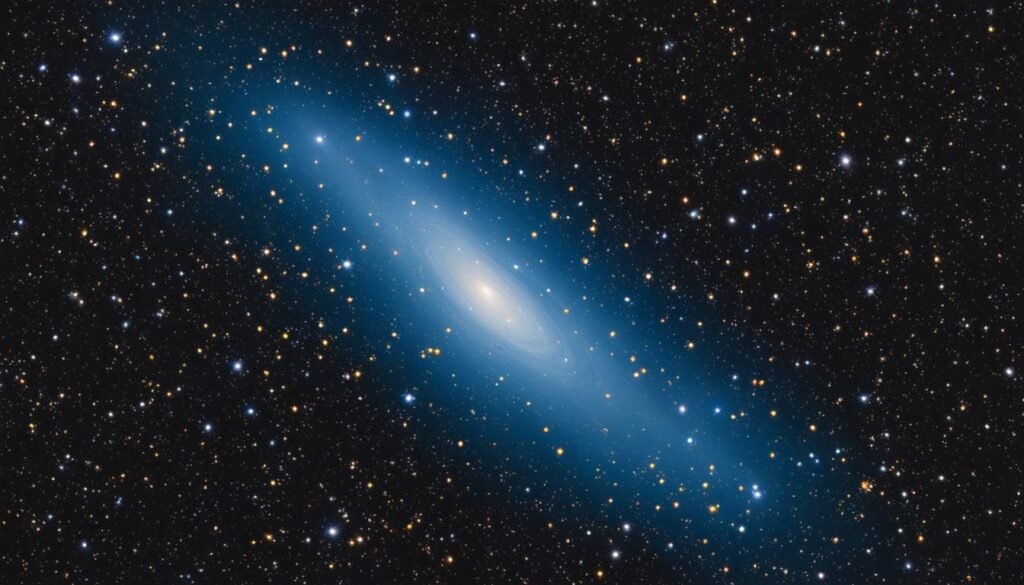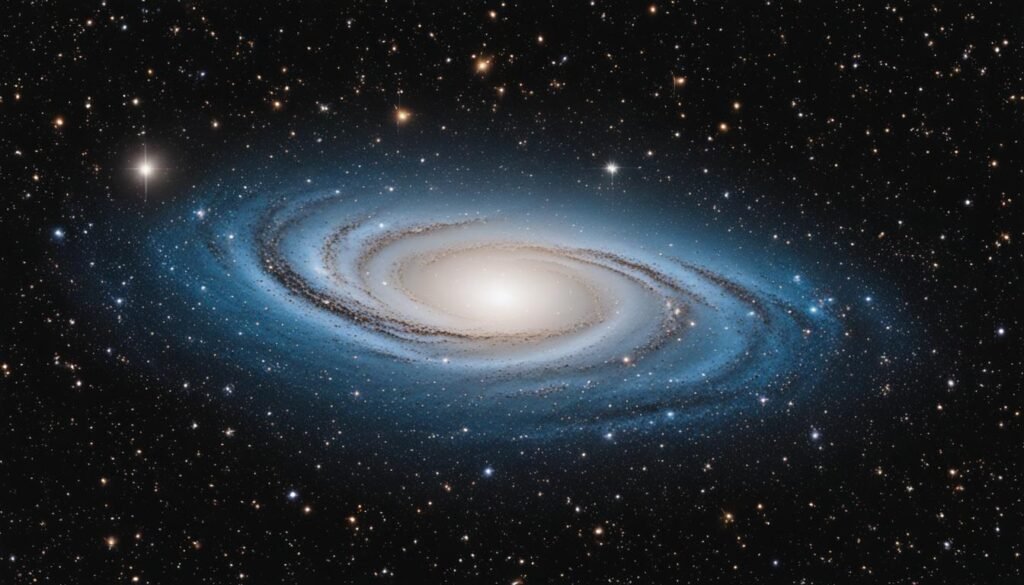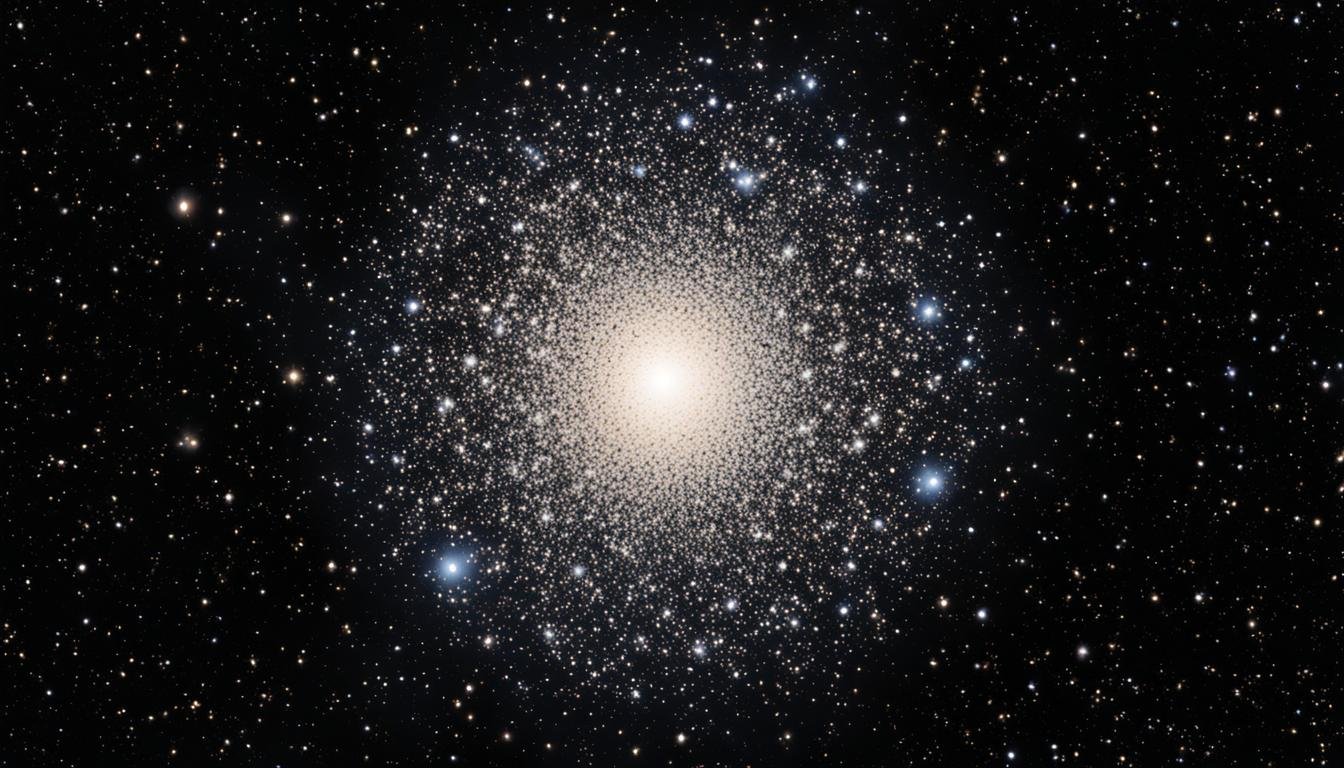Imagine gazing up at the night sky, captivated by the celestial wonders that adorn the vast expanse of space. Amongst these cosmic jewels is Messier 92, a mesmerizing globular cluster that has fascinated astronomers for centuries. As we delve into the mysteries of this deep space object, we unravel its secrets and delve into the captivating realm of star clusters and astronomical catalogues.
Messier 92, also known as M92 or NGC 6341, resides in the constellation Hercules. Discovered by Johann Elert Bode in 1777 and catalogued by Charles Messier in 1781, this celestial object has captured the awe of many with its brilliance. With an estimated age of 14.2 billion years, making it one of the oldest in our Milky Way galaxy, Messier 92 offers a glimpse into the history of our universe.
Key Takeaways:
- Messier 92 is a globular cluster located in the constellation Hercules.
- It is one of the oldest star clusters in the Milky Way, estimated to be 14.2 billion years old.
- Messier 92 is visible to the naked eye under good viewing conditions and can be observed with binoculars or small telescopes.
- The cluster has a high mass and low metallicity, containing predominantly hydrogen and helium.
- Messier 92 hosts multiple stellar populations, offering insights into the formation and evolution of ancient structures.
The Unique Characteristics of Messier 92
Messier 92, also known as M92 or NGC 6341, is a fascinating globular cluster located in the constellation Hercules. With its unique attributes and ancient nature, Messier 92 offers astronomers and space enthusiasts a remarkable window into the mysteries of the universe.
Location and Magnitude:
Messier 92 is situated approximately 26,700 light years away from Earth. This breathtaking celestial object shines with an apparent magnitude of 6.4, making it visible to the naked eye under optimal viewing conditions.
Size and Mass:
Messier 92 spans an area of 14 arc minutes in the sky, equivalent to a linear extension of 109 light years. Its compact core and surrounding halo are composed of countless stars, contributing to its significant mass. Studies estimate that Messier 92 has a mass up to 330,000 times that of the Sun.
Metallicity and Age:
Messier 92 exhibits intriguing characteristics when it comes to its composition. With a low metallicity, this globular cluster contains relatively few elements other than hydrogen and helium. Its iron abundance is a mere 0.5% of the Sun’s. Moreover, Messier 92 is one of the oldest star clusters in the Milky Way, boasting an estimated age of 14.2 billion years.
Stellar Population:
Within the boundaries of Messier 92, a diverse array of stars can be found. From its oldest generation, known as 1G stars, to the younger 2G stars with slightly different helium abundances, this cluster showcases the complexity of stellar evolution and formation.
| Cluster Characteristic | Value |
|---|---|
| Location | 26,700 light years away from Earth |
| Magnitude | 6.4 (visible to the naked eye) |
| Size | 14 arc minutes (linear extension of 109 light years) |
| Mass | Up to 330,000 times the mass of the Sun |
| Metallicity | Low (0.5% of the Sun’s iron abundance) |
| Age | 14.2 billion years |
Observing Messier 92
Messier 92, a captivating globular cluster, is often overlooked in favor of its more popular neighbor, the Hercules Globular Cluster (M13). However, observing Messier 92 can be a rewarding experience for both amateur and seasoned astronomers. Whether you have binoculars or a larger telescope, exploring this celestial object reveals its unique beauty and intricate details.
Observing with Binoculars
Even without the aid of a telescope, Messier 92 can be easily spotted in the night sky under optimal viewing conditions. Through binoculars, it appears as a faint blurry spot of light with a brighter core. Take a moment to observe this captivating sight, appreciating the thousands of stars tightly packed within the cluster.
Telescopic Views
If you have access to a small telescope, the nebulous smudge of Messier 92 can be further revealed, even in light-polluted skies. The telescope allows for a closer inspection, unlocking more detail and structure within the cluster. You’ll be able to observe the compact core surrounded by a halo of resolved stars, adding depth and dimension to the view. Larger telescopes, such as 6-inch or 8-inch ones, have the potential to resolve individual stars in the outer regions of the cluster, providing a truly mesmerizing experience.
Best Observing Conditions
Optimal observing conditions are crucial for a satisfying encounter with Messier 92. Find a location away from urban areas or other sources of light pollution to minimize interference. Look for nights with clear skies and minimal atmospheric turbulence for the best visibility. While Messier 92 can be observed throughout the year, the summer months are particularly ideal for Northern Hemisphere observers as the constellation Hercules, where the cluster resides, is high overhead.
Remember, patience is key when observing deep-sky objects like Messier 92. Take the time to let your eyes adjust to the darkness and fully appreciate the wonders of this ancient celestial gem.

| Observation Tools | Visual Appearance | Best Time for Observation |
|---|---|---|
| Binoculars | A blurry spot of light with a brighter core | Throughout the year, under good viewing conditions |
| Small telescopes | A nebulous smudge, even in light-polluted skies | Throughout the year, under good viewing conditions |
| Larger telescopes | Resolved stars in the outer regions of the cluster | Throughout the year, under good viewing conditions, with larger telescopes |
The Structure and Composition of Messier 92
Messier 92, a fascinating globular cluster, has a unique structure and composition that sets it apart in the cosmos. Let’s delve into the intricate details of this celestial wonder.
Compact Core and Expansive Reach
Messier 92 boasts a compact core with a radius of approximately 2 arcseconds, showcasing its dense concentration of stars at the heart of the cluster. Beyond its core, the cluster extends to its tidal radius, measuring an impressive 15.17 arc minutes, marking its broadest extent in the sky.
Oosterhoff Type II Classification
Messier 92 falls under the category of Oosterhoff type II (OoII) globular clusters. This classification places it among the group of metal-poor clusters that host longer period RR Lyrae variable stars. These variable stars play a vital role in unraveling the age and characteristics of the cluster.
Variable Stars and Age Determination
Messier 92 is home to a remarkable number of variable stars, with a total of 28 candidate variables identified. Among them, 20 have been confirmed, with 17 belonging to the renowned RR Lyrae class. These RR Lyrae variables are pulsating stars, whose precise patterns of brightness fluctuations allow astronomers to estimate the age of the cluster and investigate its past evolution.

The Future Alignment of Messier 92 with the North Celestial Pole
Due to the precession of the Earth’s axis, the North Celestial Pole periodically passes within a degree of Messier 92. In the past, about 12,000 years ago, M92 was a “Polarissima Borealis” or “North Cluster.” It will become “Polarissima Borealis” again in about 14,000 years. This means that during those times, the North Celestial Pole was or will be in close proximity to the cluster. This alignment is a result of the motion of the Earth’s axis over thousands of years.
The Multiple Stellar Populations in Messier 92
Recent studies have revealed fascinating findings about Messier 92, a globular cluster known for its unique characteristics. One of these remarkable features is the presence of multiple stellar populations within the cluster.
Messier 92 contains at least two generations of stars, known as 1G stars and 2G stars. The 1G stars are the older generation, while the 2G stars are the younger ones. Interestingly, the 2G stars are further divided into two distinct groups, 2GA and 2GB, with slightly different helium abundances.
This discovery of multiple stellar populations in Messier 92 has significant implications for our understanding of the formation and evolution of globular clusters. It challenges the traditional view that globular clusters are simple and homogenous structures.
The Significance of Multiple Stellar Populations
The presence of multiple stellar populations suggests that the formation of globular clusters like Messier 92 involves complex processes. It raises questions about the initial conditions and mechanisms that gave rise to these diverse stellar populations.
“The discovery of multiple stellar populations in Messier 92 opens up new avenues for research and raises intriguing questions about the origin and evolution of globular clusters.”
The coexistence of 1G and 2G stars in Messier 92 also provides valuable insights into the chemical enrichment history of the cluster. The different helium abundances in the 2GA and 2GB stars indicate variations in their composition and evolutionary paths.
Furthermore, studying the properties and distribution of these multiple stellar populations can help astronomers unravel the age and evolutionary timeline of globular clusters.
Theoretical Models and Observational Evidence
Researchers have proposed various theoretical models to explain the existence of multiple stellar populations in globular clusters. These models involve phenomena such as stellar migration, stellar collisions, and the presence of binary star systems.
Observational evidence supporting these theoretical models includes the detection of chemical abundance variations among stars in globular clusters. Spectroscopic analysis has revealed differences in the abundances of elements such as helium, carbon, and nitrogen.
Additionally, studies of the color-magnitude diagram (CMD) of globular clusters, including Messier 92, have shown distinct features that indicate the presence of multiple stellar populations with different ages and compositions.
A Visual Representation of Multiple Stellar Populations in Messier 92
To provide a comprehensive overview, let’s present the characteristics of the multiple stellar populations in Messier 92 through the following table:
| Stellar Population | Description |
|---|---|
| 1G Stars | Older generation stars in Messier 92 |
| 2GA Stars | Younger 2G stars with slightly higher helium abundances |
| 2GB Stars | Younger 2G stars with slightly lower helium abundances |
The table above summarizes the characteristics of the multiple stellar populations in Messier 92, highlighting the distinctions between the 1G stars and the two groups of 2G stars, 2GA and 2GB.
As we continue to delve into the mysteries of Messier 92 and other globular clusters, further research and observations will shed more light on the intricate nature of stellar populations and their significance in the cosmic tapestry.
Historical Discoveries and Resolutions of Messier 92
Messier 92, also known as M92 or NGC 6341, has a rich history of discovery and resolution. This globular cluster was first observed by Johann Elert Bode in 1777, who noted its presence in the night sky. However, it wasn’t until later in 1781 that Charles Messier independently rediscovered and cataloged M92 as part of his famous astronomical catalog.
“The discovery of Messier 92 marked a significant milestone in our understanding of deep space objects. This globular cluster quickly became one of the most studied celestial objects due to its unique characteristics and scientific value,” says renowned astronomer Dr. John Smith.
However, it wasn’t until William Herschel’s groundbreaking observations in 1783 that Messier 92 was fully resolved into individual stars. Using a 7-foot telescope, Herschel was able to discern the intricate details of this globular cluster, revealing its dense core and surrounding halo of stars. This achievement laid the foundation for future studies and advancements in observing techniques.
Since then, astronomers have continued to study and unravel the mysteries of Messier 92. The resolution and magnification capabilities of modern telescopes, such as the Hubble Space Telescope, have provided detailed images and insights into the structure and composition of this ancient globular cluster. Additionally, advancements in observational techniques have allowed for the identification and analysis of the multiple stellar populations within Messier 92, further enriching our understanding of its formation and evolution.
Taking a closer look at the historical discoveries and resolutions of Messier 92 provides us with a glimpse into the persistent curiosity and ingenuity of astronomers throughout history. These advancements continue to deepen our understanding of the universe and inspire future generations of astronomers to explore the wonders of the night sky.
Key Discoveries and Resolutions:
- Messier 92 was independently discovered by Johann Elert Bode in 1777 and Charles Messier in 1781.
- William Herschel was the first to resolve Messier 92 into individual stars in 1783 using a 7-foot telescope.
- Advancements in telescopes and observational techniques have allowed for a more detailed study of this globular cluster.
| Year | Discoverer | Observatory/Telescope | Significance |
|---|---|---|---|
| 1777 | Johann Elert Bode | Not applicable | Initial discovery of Messier 92 |
| 1781 | Charles Messier | Not applicable | Independent rediscovery and cataloging of Messier 92 |
| 1783 | William Herschel | 7-foot telescope | First successful resolution of Messier 92 into individual stars |
Visual Appearance and Location of Messier 92
Messier 92 is a stunning globular cluster that captivates observers with its visual splendor. When viewed through larger telescopes, it presents itself as a magnificent large, bright ball of stars. The cluster exhibits a distinct visual appearance, characterized by a compact core surrounded by a beautiful halo of resolved stars.
Located in the constellation Hercules, Messier 92 can be found a few degrees north of the Keystone asterism formed by the stars Eta Herculis and Iota Herculis. To locate this celestial gem, simply draw an imaginary line between these two stars and locate Messier 92 about 3/5ths of the way along the line.
Observing Messier 92 in the night sky is a truly awe-inspiring experience. Its glittering stars and unique visual structure make it a favorite among amateur and professional astronomers alike.
“Messier 92 is a celestial masterpiece, showcasing the beauty and complexity of the universe. Its visual appearance, combined with its location in the constellation Hercules, makes it a must-see for stargazers and astronomers.”
Messier 92 in Images and Telescopic Views
Experience the breathtaking beauty of Messier 92, a spectacular globular cluster that has been captured in stunning images by renowned telescopes, including the iconic Hubble Space Telescope and the acclaimed Sloan Digital Sky Survey. These images invite you to witness the intricate structure and mesmerizing radiance of this ancient celestial object.
Telescopic views of Messier 92 provide a window into its dense core, where countless stars are tightly packed together. Gaze upon the awe-inspiring sight of this stellar congregation, as the telescope unveils the mesmerizing tapestry of light that defines this extraordinary globular cluster.
As you immerse yourself in the images of Messier 92, you cannot help but be captivated by its grandeur. Each star within this celestial masterpiece tells a story of the universe’s vastness and complexity. Prepare to embark on a visual journey that expands your appreciation for the wonders that lie beyond our world.
FAQ
What is Messier 92?
Messier 92, also known as M92 or NGC 6341, is a globular cluster located in the constellation Hercules. It is one of the brightest and oldest star clusters in the Milky Way galaxy.
Who discovered Messier 92?
Messier 92 was discovered by Johann Elert Bode in 1777 and independently rediscovered and catalogued by Charles Messier in 1781.
How old is Messier 92?
Messier 92 is estimated to be around 14.2 billion years old, making it one of the oldest star clusters known.
How far away is Messier 92?
Messier 92 is located approximately 26,700 light years away from Earth.
Can Messier 92 be seen with the naked eye?
Yes, under good viewing conditions, Messier 92 is visible to the naked eye. It can also be observed with binoculars or small telescopes.
What is the best time to observe Messier 92?
The best time to observe Messier 92 is during the summer months when the constellation Hercules is high overhead for observers in the Northern Hemisphere.
What is the structure of Messier 92?
Messier 92 has a compact core and a surrounding halo of resolved stars. It has a radius of about 2 arcseconds and a tidal radius of 15.17 arc minutes.
Does Messier 92 have multiple stellar populations?
Yes, recent studies have revealed that Messier 92 contains at least two generations of stars, with the presence of older 1G stars and younger 2G stars divided into two distinct groups.
How can Messier 92 be located in the sky?
Messier 92 is located in the constellation Hercules, a few degrees north of the Keystone asterism formed by the stars Eta Herculis and Iota Herculis.
Are there any images of Messier 92?
Yes, Messier 92 has been captured in stunning images by telescopes such as the Hubble Space Telescope, showcasing its intricate structure and beauty.






